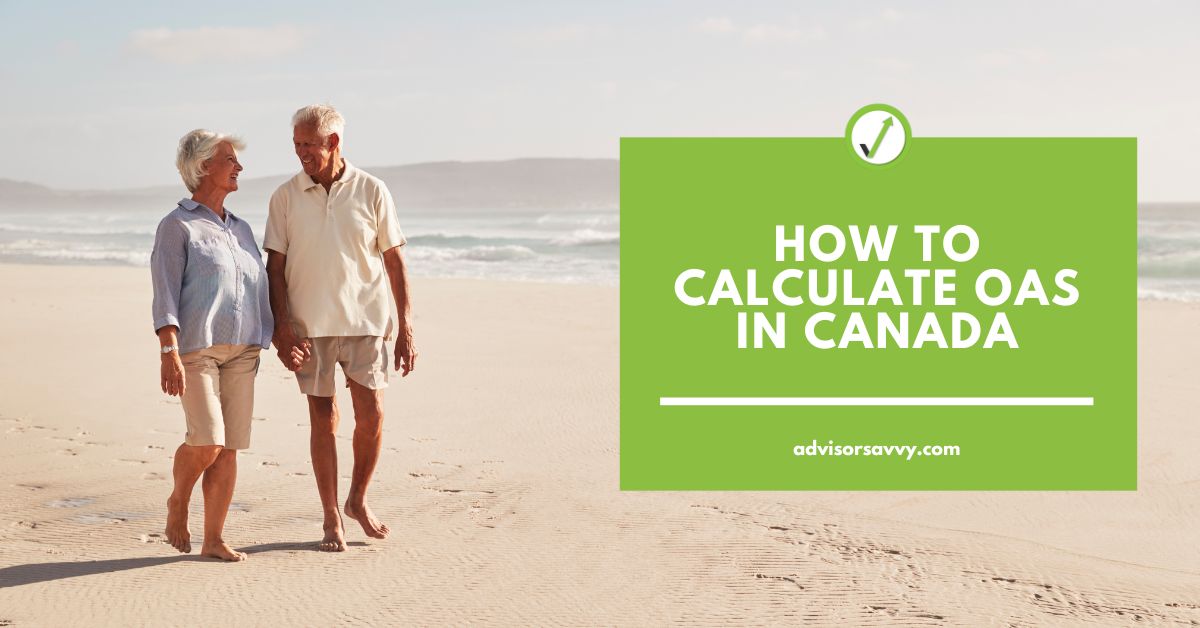
If you’re approaching retirement, estimating and forecasting monthly retirement income is important. The amount of income you expect to receive impacts your lifestyle in retirement. Many Canadians will receive the Old Age Security, or OAS for short, benefit. Normally this benefit comes into effect when Canadian citizens reach age 65. But how do you determine the amount you’ll receive? In this blog post, we’ll explore what exactly OAS is, the eligibility requirements when it comes to receiving OAS benefits, and how to calculate OAS in Canada. Continue reading to learn more!

Table of contents
What is OAS?
Old Age Security (OAS) is a pension program run by the Canadian government that provides monthly income to seniors over the age of 65 who meet the requirements. To qualify for Old Age Security, applicants must:
- Be at least 65 years of age
- Have lived in Canada for 10 or more years after they turned 18
- Be a legal resident of Canada when they apply
To receive full OAS pension payments, applicants must have lived in Canada for at least 40 years after turning 18. Otherwise, applicants will likely receive a partial benefit.
The Old Age Security pension is paid out on the last day of each month and is adjusted quarterly to reflect changes in inflation. In 2023, the maximum amount an individual can receive from this program is $687.56 per month. If the individual is aged 75 or older, the maximum amount goes up to $756.32.
The Old Age Pension Act was created in 1927 to help seniors with little to no income. It has gone through many evolutions over the century, but it serves the same purpose today. OAS payments are not meant to be a complete income source. Rather, the payments are meant to supplement income. Many retirees also receive Canada Pension Plan (CPP) and Guaranteed Income Supplement (GIS) benefits in combination with their life long savings from TFSAs, RRSPs and other pensions to finance their retirement.
Related Reading: CPP vs OAS: What are the differences?

Match to your perfect advisor now.
Getting started is easy, fast and free.
How to Calculate OAS Amounts
Calculating OAS is a bit tricky because the exact methodology of how it’s calculated is not public information. However, if you have lived in Canada for at least 40 years after turning 18, you can expect to receive the full benefit amount. Otherwise, you will likely receive a partial benefit. Fortunately, there is no income level restriction to receive OAS benefits. Only your age and residency is considered for eligibility. Below is a table of the pension limits for 2023.
| Old Age Security Age Limits | Maximum Amount |
| Ages 65 to 74 | $687.56 |
| Ages 75 and up | $756.32 |
OAS Calculator Canada
The Government of Canada has a helpful online tool that can look up your current benefit amount or help you plan for the future. Either way, it provides a reliable estimate of how much you can expect to receive from OAS. Use the link below to figure out how to calculate OAS in Canada:
How is OAS cost of living calculated?
Old Age Security benefits are tied to inflation. In other words, when inflation goes up, so does OAS benefit payments. You might be wondering, how to calculate OAS in Canada when considering the increase in inflation? The amount of the increase is calculated using the Consumer Price Index (CPI). With inflation being high in 2022, and continuing into 2023, OAS recipients can expect an increase in their benefit.
How many years do you have to live in Canada to get full OAS?
You must have lived in Canada for at least 40 years after turning 18 to receive the full OAS benefit. If you meet this criteria, you can expect to receive the maximum benefit amount each period.
Can I live outside of Canada and collect OAS?
You can receive your OAS benefit while living outside of Canada if one of the following applies:
- You lived in Canada for 20 years or more after turning 18
- You lived and worked in a country that has a social security agreement with Canada. The time you worked and lived in that country must be 20 years or more.
If you don’t meet one of these criteria, your OAS payments will stop if you’re outside of Canada for 6 months or longer.
Related Reading: Is OAS Taxable?
Things to Watch Out For
Old Age Security has some nuances to look out for, including the OAS clawback and OAS deferral. Let’s take a closer look below.
What is the OAS Clawback?
The OAS clawback (also known as Old Age Security recovery tax) is a type of income tax applied to Canadian seniors who earn income above a certain amount. The rate of the OAS clawback is 15%. It’s important to note that, while the recoupment applies to all seniors, it only affects those with higher incomes. However, if you fall in the higher income category, you can expect to pay back some or all of your benefit to the clawback. You are required to pay recovery tax if:
- Your annual, net world income exceeds $81,761 (or the respective rate for the current tax year)
- You live in a country where non-resident tax on Canadian pensions is 25% or more
Below are the clawback thresholds:
| Recovery tax period | Income year | Minimum income recovery threshold | Maximum income recovery threshold (Ages 65 to 74) | Maximum income recovery threshold Ages 75 and up |
| July 2022 to June 2023 | 2021 | $79,845 | $129,757 | $129,757 |
| July 2023 to June 2024 | 2022 | $81,761 | $134,626 | $137,331 |
| July 2024 to June 2025 | 2023 | $86,912 | $141,917 | $147,418 |
OAS Clawback Example
Here’s an example on how to calculate OAS in Canada when considering the clawback. In 2022, Harold’s net world income was $100,000. The limit in 2022 was $81,761 which means Harold owes 15% tax on the difference between his income and the limit. This is calculated as follows:
$100,000 – $81,761 = $18,239
$18,239 x 15% = $2,735.85
Harold would owe $2,735.85 for the 2022 year in OAS clawback tax for the June 2023 to June 2024 period. Normally, this tax is divided by 12 and is paid back monthly to aide cashflow for seniors. So, Harold would have to pay back $227.99 per month.
Is OAS calculated on gross or net income?
OAS is calculated on net world income, not gross income. This is a good thing for OAS recipients because you have the opportunity to take advantage of deductions before determining if the OAS clawback applies to you.
OAS Deferral
Old Age Security Deferral is a strategy available to Canadians who qualify for the Old Age Security (OAS) pension. By deferring, you can receive a higher monthly pension amount than if you had claimed it at the earliest eligible age of 65. It essentially involves delaying when you begin receiving your OAS payments until later in life, usually between ages 65 and 70.
Generally speaking, people who are comfortable with their current financial situation may benefit from deferring their OAS payments for as long as possible – up to age 70 – since this will result in a higher monthly payment. On the other hand, those who need immediate income or have health concerns may decide to take the pension earlier and use it to supplement their existing income.
What is the new OAS amount for 2023?
In 2023, the OAS amount is $687.56 for individuals aged 65 to 74. Those over the age of 75 can receive up to $756.32.
In 2022, there were some changes to the Old Age Security amounts. As of July 2022, the pension amount permanently increased by 10% for individuals aged 75 and over.
How to use OAS to your Advantage?
Now that you know how to calculate OAS in Canada, you can begin your retirement planning. Old Age Security is meant to supplement your income in retirement. It is commonly used alongside Canada Pension Plan (CPP) and Guaranteed Income Supplement (GIS) to form a stable, reliable income for retirees and seniors. By utilizing all three programs, you can use OAS to your advantage.
In addition, holding off on claiming your OAS benefit can be advantageous. If you don’t start claiming OAS until you reach the age of 70, you’ll receive a higher monthly amount than if you had started making claims at age 65. Of course, sometimes waiting isn’t an option. But if you don’t need OAS income at 65, waiting until age 70 can be financially beneficial.
Lastly, many Canadians rely on other retirement savings, such as income from their RRSP, TFSA, pension or other investments. If you can, try to build up other savings so you’re not entirely dependent on the Old Age Security program. The more resources you have, the more financially relaxed your retirement can be!
Read More: How to Find and Choose a Financial Coach
